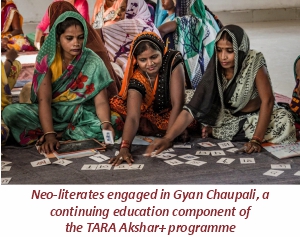India’s New
Education Policy 2020:
An Analysis
State of Adult Literacy in India
India
has made huge progress on the adult literacy front after
independence, especially for girls. Yet the number of adult female
illiterates in India remains alarmingly high at around 168 million of whom
majority are in rural areas.1 The literacy rate rose to 65.46% in
2011 from 53.67% in 2001. Despite this, rural India still has 136 million
adult female illiterates. There are about 332 districts in India with a
female illiteracy rate of above 50%. 2
While primary education received focus, adult literacy was neglected in the first few decades after independence. It was only after 1970 that a nation-wide mission was launched where adult education was largely tied to nation building but it lacked in people’s participation.
Adult literacy programmes have not had steady support and these have fallen off the government’s priority list. Government-funded adult education has remained overlooked most of the time. The states continue to ignore their roles and responsibilities. There is a tendency for dependence on private participation on this front, but private players also do not want to focus on the area where remunerative outcomes are not possible.

New Possibilities: The New Education Policy (NEP) 2020
Now in 2021, we look forward to the implementation of the New Education Policy (NEP) that grandiosely sets up an outcome to achieve 100% adult literacy by 2030. This will be culminating favourably only after effective execution of ideas such as adult education curriculum framework that will be developed for literacy, numeracy, basic education, vocational skills, critical life skills and beyond. The framework would keep in mind that adults will require rather different pedagogy and materials. Adult Education Centres (AECs) would also be included within other public infrastructure and social counsellors would be associated with them to mobilise adults and connect them with the AECs. However, what is interesting is to see how in the NEP, Adult Education seems to be welfare centric but education for children and youth is acutely restrictive to employability skills and vocational training.
Existing Evidence: Overview of TARA Akshar+

Incidentally, TARA Akshar+, a flagship literacy programme of the Development Alternatives Group, has already been delivering a similar framework. This programme has been working with the singular focus to enable illiterate adult women to achieve functional literacy and beyond through its continuing education programme. 6 month long continuing education aspect of the programme works to build self-reliance and self-assertion alongside linking women to income generating activities. An economic impact of the programme done by the TARA Akshar+ team for 1948 women in 2019 showed how literacy with the right skills and guidance can help anyone achieve great heights in life. Some sought employment and others have become entrepreneurs or proud shop owners. Providing unlettered women, the boon of literacy has had a positive impact on the GDP of India. From being capable enough to earn a living to adding close to INR 2.6 crores to the income of India in 2 years, these 1948 neo-literates have come a long way.
Way Forward
The New Education Policy 2020 must act as a steppingstone towards reclaiming the pedestal India has lost in Adult Education through National Literacy Mission - as a country which in the 1990s drastically improved its literacy rate and increased school enrolment and not as a distraction to sway people away from the real issues in education. We hope that the learnings from programmes like TARA Akshar+ can inform policy implementation and a robust Adult Literacy Programme comes in existence and the issue of adult literacy is given its due credit. ■
Endnotes
1Census (2011), Ministry of Home
Affairs, Government of India
2Census (2011), Ministry of Home Affairs, Government of India
Tejashwani
tejashwani@devalt.org